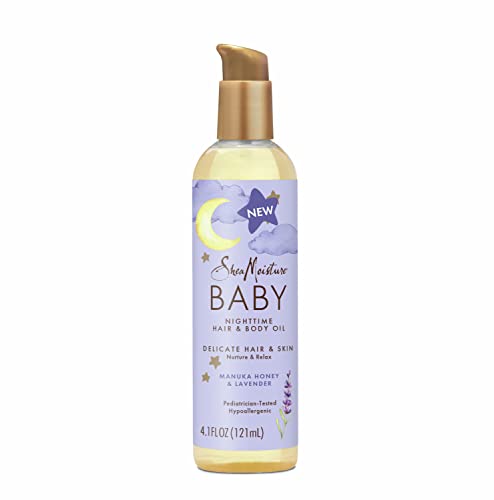


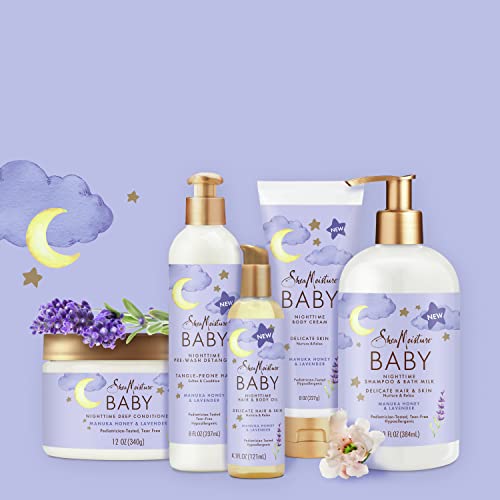

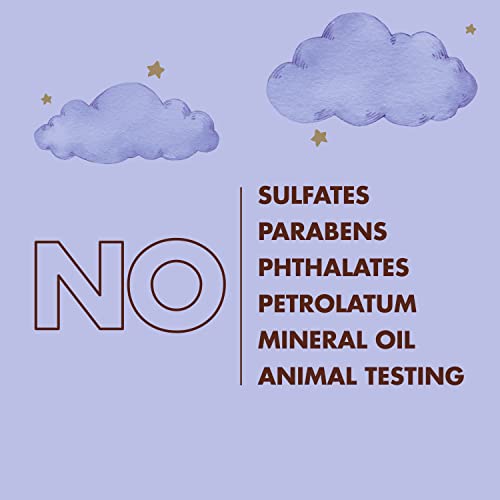

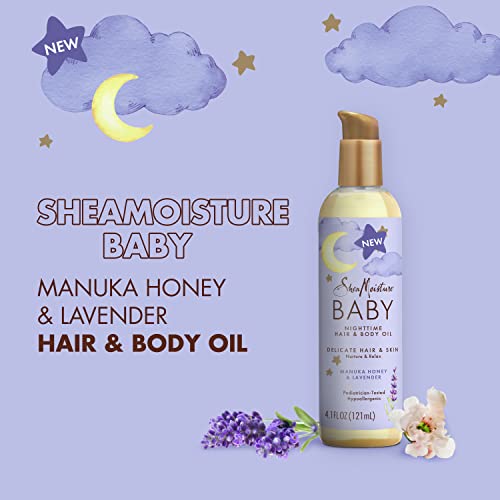
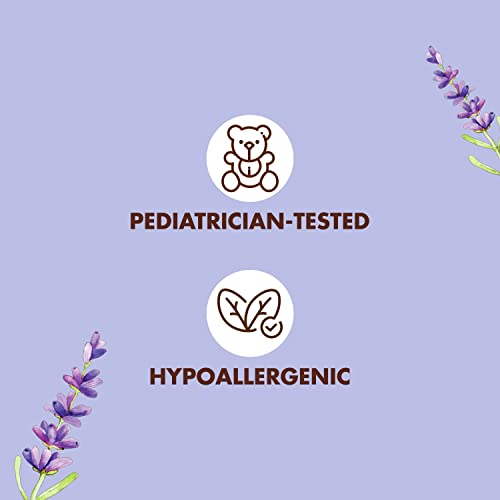
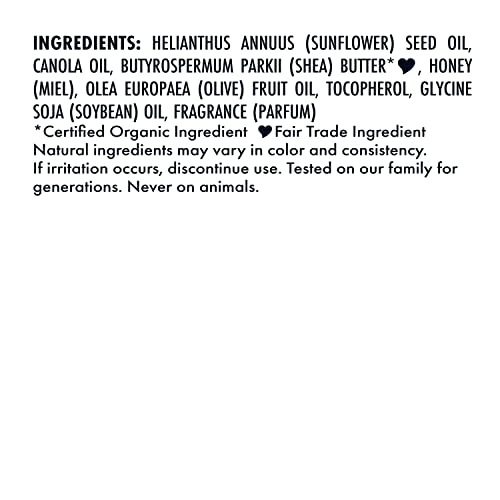

SheaMoisture Baby Body Oil - Moisturizes Delicate Skin & Hair, Manuka Honey & Lavender - 4.1oz


Fragrance
High RiskFragrance refers to a mixture of aromatic compounds used in products to provide scent. It is commonly listed as 'fragrance' or 'parfum' on product labels and can serve various functions, including enhancing user experience and masking undesirable odors.
Sustai Insights
Fragrance offers functional benefits by improving product appeal; however, it poses significant health risks, notably a high likelihood of causing allergies and allergic contact dermatitis. Environmental risks include potential pollution and endocrine disruption, though its overall carcinogenicity is low. Regulatory bodies have noted concerns regarding its use, leading to a high-risk classification. Safe usage practices should be observed, and alternatives such as natural essential oils are recommended for those sensitive to synthetic fragrances.
Butyrospermum Parkii (Shea) Butter
Low RiskButyrospermum parkii (shea) butter is a vegetable fat derived from the nuts of the shea tree. It is commonly used in cosmetic formulations for its emollient properties, providing moisture and improving skin texture. Additionally, shea butter is known for its ability to enhance the stability of products and deliver a creamy texture.
Sustai Insights
Shea butter offers functional benefits as an effective moisturizer, enhancing skin barrier function and texture. It is sustainably sourced and biodegradable, contributing to eco-friendliness. Health-wise, it is associated with low risks for carcinogenicity, allergies, and reproductive toxicity. Environmental impacts are minimal, with no significant pollutant potential identified. Regulatory assessments indicate no current restrictions. Overall, the ingredient presents a low risk, making it a favorable choice in cosmetic formulations.
Helianthus Annuus (Sunflower) Seed
Low RiskHelianthus annuus (sunflower) seed is derived from the seeds of the sunflower plant and is commonly used in various cosmetic and personal care products. It serves primarily as an emollient and skin conditioning agent, providing moisture and enhancing the texture of formulations.
Sustai Insights
Helianthus annuus (sunflower) seed offers functional benefits, including skin conditioning and moisturizing properties, while being sustainably sourced and biodegradable. Health risks are minimal, with low concerns for carcinogenicity, allergies, and reproductive toxicity. Environmentally, it presents low risks of pollution or bioaccumulation. Regulatory assessments indicate no current restrictions. Overall, it is considered a low-risk ingredient, and safe usage practices should be maintained. Alternative ingredients may include other plant-based oils, but the sunflower seed oil remains a viable option.
Glycine Soja (Soybean) Oil
Low RiskGlycine soja (soybean) oil is derived from the seeds of the soybean plant and is commonly used in cosmetic formulations for its emollient properties. It functions as a moisturizer and skin conditioning agent, enhancing the texture and feel of products.
Sustai Insights
Glycine soja (soybean) oil offers functional benefits such as effective skin moisturization and conditioning. It is generally recognized as low-risk for health concerns, with minimal allergenic potential and no significant environmental hazards reported. Regulatory bodies have not imposed restrictions on its use. Overall, this ingredient is assessed as low risk, making it a suitable option for various cosmetic applications.
Olea Europaea (Olive) Oil
Low RiskOlea europaea (olive) oil is derived from the ripe fruit of the olive tree. It is commonly used in cosmetic formulations primarily as a moisturizer and emollient due to its nourishing properties for the skin. It also serves as a carrier oil for other ingredients in formulations.
Sustai Insights
Olea europaea (olive) oil offers numerous functional benefits, including effective moisturization and enhanced skin absorption properties, making it suitable for various cosmetic applications. It is a biodegradable ingredient, contributing to sustainability when sourced responsibly. Health risks are low, with minimal concerns regarding carcinogenicity, allergenic potential, and developmental toxicity. Environmental risks are also low, with no significant bioaccumulation or pollution potential noted. Regulatory bodies do not impose restrictions on its use. Overall, olive oil presents a low risk profile, making it a favorable choice in cosmetic products.
Tocopherol, D Alpha
Low RiskTocopherol, specifically d-alpha tocopherol, is a naturally occurring form of Vitamin E. It is commonly used in cosmetic and personal care products primarily for its antioxidant properties, helping to protect formulations from oxidation and extend shelf life.
Sustai Insights
D-alpha tocopherol provides effective antioxidant benefits, contributing to product stability. It is sustainably sourced and generally regarded as safe, with low concerns regarding carcinogenicity, allergies, and reproductive toxicity. However, there are minor concerns about endocrine disruption. Regulatory bodies have not imposed significant restrictions, indicating low overall risk. Recommended usage practices include adhering to established safe concentration thresholds. Alternatives, such as other forms of Vitamin E or plant-based antioxidants, may also be considered.
Coco Caprylate/Caprate
Low RiskCoco-caprylate/caprate is a mixture of esters derived from coconut oil, primarily used as an emollient and skin-conditioning agent in cosmetic formulations. It enhances the texture and spreadability of products, providing a silky feel on the skin without leaving a greasy residue.
Sustai Insights
Coco-caprylate/caprate serves effectively as an emollient, offering a silky texture to formulations while being biodegradable and sourced sustainably from coconut oil. Health risks are minimal, with low concerns regarding carcinogenicity, allergies, or reproductive toxicity. Environmental risks are also considered low, with no significant pollutant or bioaccumulation potential. Regulatory bodies have not imposed significant restrictions on its use, indicating a favorable safety profile. Overall, the ingredient is assessed to have a low risk, and safer alternatives are limited but may include other natural emollients.
Honey
Low RiskHoney is a saccharic secretion gathered and stored by honeybees, primarily composed of sugars such as fructose and glucose. It is commonly used in cosmetic products for its humectant properties, helping to retain moisture and improve skin hydration.
Sustai Insights
Honey offers functional benefits such as moisturizing and soothing properties, contributing to skin care formulations. It has a low risk of health concerns, including potential allergenic reactions and endocrine disruption. Environmentally, honey is generally sustainable, being biodegradable and often sourced ethically. Regulatory bodies place low restrictions on its use, but it should be avoided by individuals with bee allergies. Overall, the ingredient presents a low risk profile for consumers.
Butyrospermum Parkii (Shea) Butter
Low RiskButyrospermum parkii (shea) butter is a vegetable fat derived from the nuts of the shea tree. It is commonly used in cosmetic formulations for its emollient properties, providing moisture and improving skin texture. Additionally, shea butter is known for its ability to enhance the stability of products and deliver a creamy texture.
Sustai Insights
Shea butter offers functional benefits as an effective moisturizer, enhancing skin barrier function and texture. It is sustainably sourced and biodegradable, contributing to eco-friendliness. Health-wise, it is associated with low risks for carcinogenicity, allergies, and reproductive toxicity. Environmental impacts are minimal, with no significant pollutant potential identified. Regulatory assessments indicate no current restrictions. Overall, the ingredient presents a low risk, making it a favorable choice in cosmetic formulations.
Helianthus Annuus (Sunflower) Seed
Low RiskHelianthus annuus (sunflower) seed is derived from the seeds of the sunflower plant and is commonly used in various cosmetic and personal care products. It serves primarily as an emollient and skin conditioning agent, providing moisture and enhancing the texture of formulations.
Sustai Insights
Helianthus annuus (sunflower) seed offers functional benefits, including skin conditioning and moisturizing properties, while being sustainably sourced and biodegradable. Health risks are minimal, with low concerns for carcinogenicity, allergies, and reproductive toxicity. Environmentally, it presents low risks of pollution or bioaccumulation. Regulatory assessments indicate no current restrictions. Overall, it is considered a low-risk ingredient, and safe usage practices should be maintained. Alternative ingredients may include other plant-based oils, but the sunflower seed oil remains a viable option.
Glycine Soja (Soybean) Oil
Low RiskGlycine soja (soybean) oil is derived from the seeds of the soybean plant and is commonly used in cosmetic formulations for its emollient properties. It functions as a moisturizer and skin conditioning agent, enhancing the texture and feel of products.
Sustai Insights
Glycine soja (soybean) oil offers functional benefits such as effective skin moisturization and conditioning. It is generally recognized as low-risk for health concerns, with minimal allergenic potential and no significant environmental hazards reported. Regulatory bodies have not imposed restrictions on its use. Overall, this ingredient is assessed as low risk, making it a suitable option for various cosmetic applications.
Olea Europaea (Olive) Oil
Low RiskOlea europaea (olive) oil is derived from the ripe fruit of the olive tree. It is commonly used in cosmetic formulations primarily as a moisturizer and emollient due to its nourishing properties for the skin. It also serves as a carrier oil for other ingredients in formulations.
Sustai Insights
Olea europaea (olive) oil offers numerous functional benefits, including effective moisturization and enhanced skin absorption properties, making it suitable for various cosmetic applications. It is a biodegradable ingredient, contributing to sustainability when sourced responsibly. Health risks are low, with minimal concerns regarding carcinogenicity, allergenic potential, and developmental toxicity. Environmental risks are also low, with no significant bioaccumulation or pollution potential noted. Regulatory bodies do not impose restrictions on its use. Overall, olive oil presents a low risk profile, making it a favorable choice in cosmetic products.
Tocopherol, D Alpha
Low RiskTocopherol, specifically d-alpha tocopherol, is a naturally occurring form of Vitamin E. It is commonly used in cosmetic and personal care products primarily for its antioxidant properties, helping to protect formulations from oxidation and extend shelf life.
Sustai Insights
D-alpha tocopherol provides effective antioxidant benefits, contributing to product stability. It is sustainably sourced and generally regarded as safe, with low concerns regarding carcinogenicity, allergies, and reproductive toxicity. However, there are minor concerns about endocrine disruption. Regulatory bodies have not imposed significant restrictions, indicating low overall risk. Recommended usage practices include adhering to established safe concentration thresholds. Alternatives, such as other forms of Vitamin E or plant-based antioxidants, may also be considered.
Fragrance
High RiskFragrance refers to a mixture of aromatic compounds used in products to provide scent. It is commonly listed as 'fragrance' or 'parfum' on product labels and can serve various functions, including enhancing user experience and masking undesirable odors.
Sustai Insights
Fragrance offers functional benefits by improving product appeal; however, it poses significant health risks, notably a high likelihood of causing allergies and allergic contact dermatitis. Environmental risks include potential pollution and endocrine disruption, though its overall carcinogenicity is low. Regulatory bodies have noted concerns regarding its use, leading to a high-risk classification. Safe usage practices should be observed, and alternatives such as natural essential oils are recommended for those sensitive to synthetic fragrances.
Coco Caprylate/Caprate
Low RiskCoco-caprylate/caprate is a mixture of esters derived from coconut oil, primarily used as an emollient and skin-conditioning agent in cosmetic formulations. It enhances the texture and spreadability of products, providing a silky feel on the skin without leaving a greasy residue.
Sustai Insights
Coco-caprylate/caprate serves effectively as an emollient, offering a silky texture to formulations while being biodegradable and sourced sustainably from coconut oil. Health risks are minimal, with low concerns regarding carcinogenicity, allergies, or reproductive toxicity. Environmental risks are also considered low, with no significant pollutant or bioaccumulation potential. Regulatory bodies have not imposed significant restrictions on its use, indicating a favorable safety profile. Overall, the ingredient is assessed to have a low risk, and safer alternatives are limited but may include other natural emollients.
Honey
Low RiskHoney is a saccharic secretion gathered and stored by honeybees, primarily composed of sugars such as fructose and glucose. It is commonly used in cosmetic products for its humectant properties, helping to retain moisture and improve skin hydration.
Sustai Insights
Honey offers functional benefits such as moisturizing and soothing properties, contributing to skin care formulations. It has a low risk of health concerns, including potential allergenic reactions and endocrine disruption. Environmentally, honey is generally sustainable, being biodegradable and often sourced ethically. Regulatory bodies place low restrictions on its use, but it should be avoided by individuals with bee allergies. Overall, the ingredient presents a low risk profile for consumers.
Discover the SheaMoisture Baby Hair and Body Oil, a gentle blend of Manuka Honey and lavender designed for delicate hair and skin. This nurturing oil fosters bonding moments while providing a calming nighttime routine.
- Gentle Moisturization: Infused with plant-based oils, this body oil hydrates and soothes, leaving baby's skin and hair soft and nourished.
- Relaxing Aroma: The soothing lavender scent creates a tranquil atmosphere, perfect for bedtime bonding and relaxation.
- Pediatrician-Tested: Hypoallergenic and pediatrician-tested, this oil is crafted for babies with melanin-rich skin and textured hair, ensuring safety and effectiveness.
- Versatile Use: Ideal for post-bath hydration, a calming massage, or to lock in moisture for hair, making it a must-have in your baby care routine.
- Sustainably Produced: Committed to ethical practices, SheaMoisture products are cruelty-free and sustainably sourced, promoting a healthier planet for future generations.
Subscribe & Save with Sustai
- Best Price Guarantee: Always enjoy the lowest prices on sustainable home essentials.
- No Surprises: We’ll notify you before shipping. No hidden fees, ever.
- You’re in Charge: Change, pause, or cancel your subscription anytime with ease.
- Eco-Friendly Deliveries: Our grouped shipments mean less packaging and lower emissions.
Join us on a sustainable journey. Special offers for a limited time! Prices and promotions may change.
Recommended Products
Discover the SheaMoisture Baby Hair and Body Oil, a gentle blend of Manuka Honey and lavender designed for delicate hair and skin. This nurturing oil fosters bonding moments while providing a calming nighttime routine.
- Gentle Moisturization: Infused with plant-based oils, this body oil hydrates and soothes, leaving baby's skin and hair soft and nourished.
- Relaxing Aroma: The soothing lavender scent creates a tranquil atmosphere, perfect for bedtime bonding and relaxation.
- Pediatrician-Tested: Hypoallergenic and pediatrician-tested, this oil is crafted for babies with melanin-rich skin and textured hair, ensuring safety and effectiveness.
- Versatile Use: Ideal for post-bath hydration, a calming massage, or to lock in moisture for hair, making it a must-have in your baby care routine.
- Sustainably Produced: Committed to ethical practices, SheaMoisture products are cruelty-free and sustainably sourced, promoting a healthier planet for future generations.

You can have at most 2 Sustainable Steals products in your cart
Customer Reviews
Customers’ View
Customers appreciate the gentle hydration and calming aroma of SheaMoisture Baby Hair and Body Oil, noting its effectiveness in moisturizing both hair and skin. Many users highlight the lovely lavender scent, describing it as soothing and perfect for bedtime routines. The oil's lightweight texture is frequently mentioned, with parents reporting positive results for post-bath massages and its ability to keep skin soft and smooth. While some customers express concerns about leakage during shipping and a few mixed reviews on oiliness, overall sentiments reflect satisfaction with the product's safety and functionality for delicate baby skin. Environmentally conscious users value the product's cruelty-free and sustainable production methods, reinforcing its appeal for health-conscious families. In summary, customers find this oil to be a valuable addition to their baby's care routine, promoting relaxation and skin nourishment.
AI-generated from the text of customer reviewsThis product is rated 4.6 of 5.0 stars.
It has received 23 reviews.




